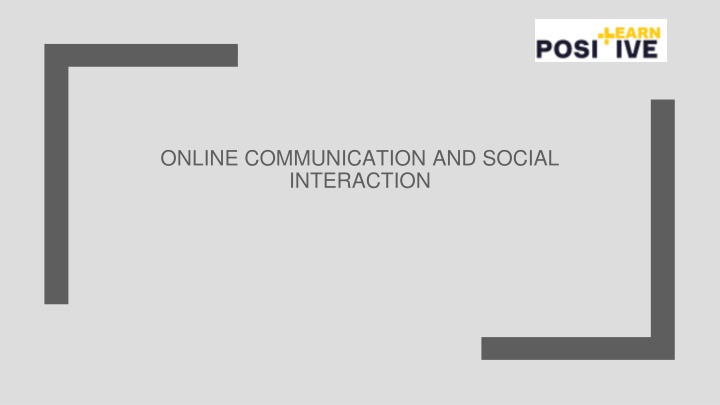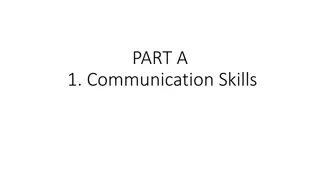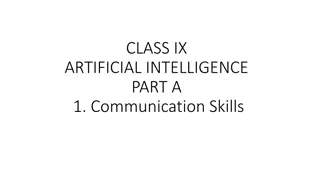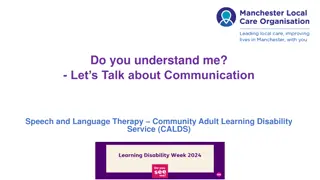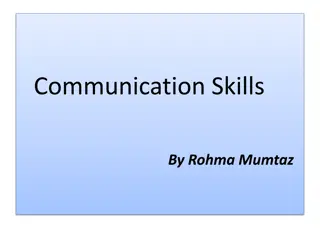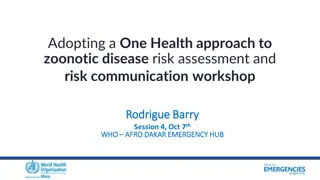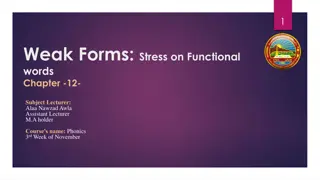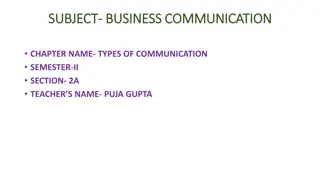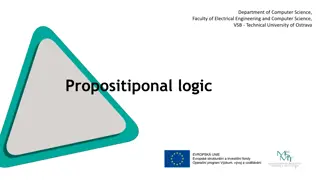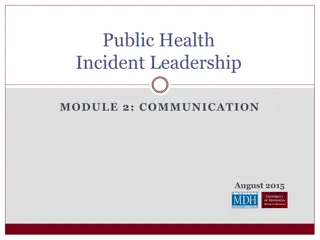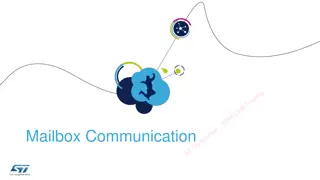Online Communication: Forms, Advantages, Challenges
Online communication involves exchanging information through digital platforms like social media, email, messenger services, video conferencing, forums, and more. It offers real-time interactions regardless of location, but comes with challenges like technostress. Explore different forms of online communication, its benefits, and the strategies to cope with challenges.
Uploaded on Apr 12, 2025 | 0 Views
Download Presentation

Please find below an Image/Link to download the presentation.
The content on the website is provided AS IS for your information and personal use only. It may not be sold, licensed, or shared on other websites without obtaining consent from the author.If you encounter any issues during the download, it is possible that the publisher has removed the file from their server.
You are allowed to download the files provided on this website for personal or commercial use, subject to the condition that they are used lawfully. All files are the property of their respective owners.
The content on the website is provided AS IS for your information and personal use only. It may not be sold, licensed, or shared on other websites without obtaining consent from the author.
E N D
Presentation Transcript
ONLINE COMMUNICATION AND SOCIAL INTERACTION
Index What is online communication? Different forms of online communication Advantages and challenges of online communication Technostress What is it? Causes of technostress in online communication Examples of technostress situations Impact of Technostress Technostress through online communication and social interaction Case studies Strategies for coping with technostress Enhancing Online Communication
What is online communication? Online communication is exchanging information and messages via digital platforms and networks. This can occur via various media, including emails, social networks, chat services, video conferencing, and online forums. Online communication enables people to interact in real-time or asynchronously, regardless of location. It can occur formally in professional environments and informally in social contexts. With the increasing digitalization of everyday life, online communication has become essential to personal and professional exchanges.
Different forms of online communication Online communication includes a variety of forms and platforms that allow people to share and receive information and messages digitally. The different types of online communication include: 1. social media: platforms like Facebook, Instagram, Twitter, LinkedIn, and TikTok where users can create and share content and interact. These platforms allow the sharing of personal experiences, opinions, and news. 2. Email is a formal and widespread digital communication used for personal, business, and academic purposes. Emails enable the exchange of messages and documents between individuals or groups. 3. Messenger services: Instant messaging platforms such as WhatsApp, Telegram, Signal, and Facebook Messenger offer the possibility of real-time text messages and voice and video calls. They are often used for private and informal communication. 4. video conferencing tools: Platforms such as Zoom, Microsoft Teams, Google Meet, and Skype allow users to conduct virtual meetings with audio and video. They are often used for business meetings, online teaching, and virtual gatherings. 5. online forums and discussion platforms: Websites such as Reddit, Quora, or specialized forums where users can discuss, ask questions, and provide answers on specific topics. 6. blogs and vlogs: Platforms such as WordPress, Blogger, or YouTube where users publish longer content in texts (blogs) or videos (vlogs) to share their thoughts, experiences, or knowledge. 7. collaboration tools: Platforms such as Slack, Asana, or Trello, which are specifically designed for team collaboration and offer features such as task management, file sharing, and group communication. Each of these forms of communication has its characteristics and is selected according to need and context. Choosing the proper means of communication can depend on factors such as the level of formality, the urgency of the message, the desired audience, and the type of information to be communicated.
Advantages and challenges of online communication Online communication offers a number of advantages but also brings specific challenges: Positive aspects of online communication speed: online communication enables the rapid exchange of information. Messages and responses can be sent and received in real time, making communication more efficient. 1. convenience: The ability to communicate virtually anywhere with internet access offers a high level of convenience. People can easily maintain connections regardless of geographical distance. 2. accessibility: online platforms offer multiple communication methods, accessible to different needs and preferences - from text messages to voice and video calls to social media. 3. diversity of communication forms: Online tools offer different types of communication - written, audiovisual, and multimedia content - allowing for more prosperous and creative forms of expression. 4. networking: online platforms make establishing and maintaining professional and personal networks easier. 5.
Advantages and challenges of online communication Online communication offers a number of advantages but also brings specific challenges Challenges of online communication: 1. Misunderstandings: The absence of non-verbal communication (such as body language and tone of voice) in text messages can lead to misunderstandings as the emotional context of a message may be missing. 2. Information overload: the constant availability of information and the ease with which messages can be sent and received often leads to an overload that makes distinguishing the important from the unimportant difficult. 3. Digital divide: only some have equal access to digital devices and the internet, which can lead to a divide in communication reach. 4. privacy and security: Online communication poses privacy and data security risks. Personal information can be vulnerable to unauthorized access and misuse. 5. Social isolation: Overreliance on online communication can reduce face-to-face interactions and increase feelings of isolation and alienation. 6. Online conflicts and cyberbullying: the anonymity and distance offered by the internet can lead to inconsiderate behavior, online conflicts, and cyberbullying. Communicating effectively online is taking advantage of the positive aspects while recognizing and overcoming the challenges. This requires conscious management of one's online presence, communication habits, and how digital technologies are used.
Technostress What is it? Technostress is a term that describes the stress that arises from using or interacting with technology.
Technostress What is it? This stress can have multiple causes and manifest itself in different forms. Some of the main characteristics of technostress are: 1. Technology overwhelms the feeling of being overwhelmed by digital technologies' constant presence and demands. Persistent notifications can cause this, as can the need to be constantly available or the sheer amount of information that needs to be processed online. 2. pressure to adapt: the need to continually adapt to new technologies, software updates, or digital tools can cause stress, especially for people who have difficulty with technological change 3. privacy and security concerns: concerns about personal information and data security in the digital space can also lead to technostress. 4. Social and professional impact: The way technology affects social interactions and the world of work can also cause stress, whether through changing forms of communication or the expectation to be available outside of regular working hours. 5. digital dependency: An over-reliance on digital devices and the feeling of being unable to function without them can also cause stress. Technostress can have far-reaching effects on physical and mental health, including symptoms such as fatigue, irritability, sleep disturbances, and reduced quality of life. To manage technostress, it is essential to find a balance in your use of technology, take breaks from digital devices, and use conscious strategies to manage stress.
Causes of technostress in online communication Identifying factors in online communication that can lead to technostress is crucial to developing effective coping strategies. These factors include: 1. Information overload: the vast amount of information available online and constantly being updated can be overwhelming and lead to stress. By understanding these factors, individuals and organizations can develop targeted strategies to minimize the risk of technostress and promote a healthier digital environment. 2. Constant accessibility: the expectation to always be online and available, especially in social media and professional contexts, can lead to feelings of constant stress and exhaustion. 3. Multitasking demands: Managing multiple online communication channels simultaneously can lead to overload and stress. 4. Lack of non-verbal cues: Online communication often lacks the non-verbal cues in face-to-face conversations. This can lead to misunderstandings and conflicts, which can cause stress 5. Concerns about privacy and security: concerns about protecting personal data and security online can also lead to stress. 6. Social comparisons and cyberbullying: On social media, social comparisons and negative interactions such as cyberbullying can lead to increased stress 7. Technical problems and disruptions: Technical difficulties or internet connection interruptions can also cause stress, especially during essential tasks or communications. 8. Fast-paced digital trends: the pressure to keep up with the latest digital trends and technologies can also be stressful. 9. Work-related stress: The merging of work and personal life, especially with telecommuting and online communication, can lead to a lack of separation between work and rest.
Examples of technostress situations: Real-life examples show how technostress can arise Technostress is a phenomenon that can occur in many everyday situations. Here are some real-life examples that show how technostress can arise: 1. email overload at work: an office worker starts their day with hundreds of unread emails. Going through and prioritizing these messages can be overwhelming and lead to stress. 2. online meetings and video conferencing exhaustion: a teacher who teaches classes all day via video conferencing can feel exhausted as the constant focus on the screen and lack of direct human interaction can be stressful. 3. Constant notifications from social media: A teenager constantly receiving notifications from various social media sites can feel stressed and pressured to respond immediately, leading to anxiety and feeling overwhelmed. 4. working outside of regular working hours: An employee who continues to receive emails and messages from supervisors and coworkers after hours may have difficulty relaxing and disconnecting from work. 5. technical problems during important tasks: A person giving an important online presentation and facing technical difficulties such as a poor internet connection or software issues may experience stress and frustration. 6. cyberbullying: Young people or even adults who experience negative comments or cyberbullying on social media can experience increased stress and psychological strain. 7. Digital surveillance in the workplace: Employees who are aware of their employer's constant monitoring of their online activities can experience stress and anxiety as they must constantly monitor their performance and behavior. 8. Information overload: A person trying to keep up to date with current news and developments may feel overwhelmed by the sheer volume of information and often conflicting information. 9. online learning: students adapting to online learning may experience stress from the lack of social interaction, technical challenges, and the need for self-motivation. In all of these examples, the specific challenges of digital technology can lead to psychological stress, referred to as technostress. It is essential to develop strategies to manage this stress, such as time management, digital breaks, and conscious boundaries between work and leisure.
Impact of Technostress Psychological and physical effects The effects of technostress are wide- ranging and affect both mental and physical well-being. It is crucial to raise awareness of these effects and take proactive measures to manage stress, such as taking regular breaks from digital devices, conscious time management, ergonomic workplace design, and promoting relaxation and mindfulness practices. The effects of technostress on mental and physical well-being are varied and can be profound: Mental well-being 1. increased stress and anxiety: Constant accessibility and the need to always be on top of the latest technology can lead to increased stress and anxiety. 2. Burden and burnout: The information overload and multitasking that often accompany the use of digital technologies can lead to feelings of being overwhelmed and contribute to burnout in the long term. 3. sleep disorders: The use of screen devices, especially before bedtime, can disrupt the sleep cycle and lead to sleep disturbances, negatively impacting mental health. 4. lack of concentration: Constant interruptions from digital devices can impair the ability to concentrate intensely and lead to fragmented attention. 5. social isolation: Although digital technologies often promote social connection, they can also lead to a reduction in direct, face-to-face interactions, increasing feelings of social isolation. Physical wellbeing 1. eye strain and vision problems: Long screen time can lead to eye strain, dryness, and vision problems. 2. postural problems: poor posture when using digital devices can lead to back, neck, and shoulder problems 3. fatigue and loss of energy: Technostress can lead to general fatigue and a loss of power, affecting physical health. 4. Lifestyle changes: Increased use of digital technologies can contribute to a sedentary lifestyle, which is linked to various health problems such as heart disease, diabetes, and weight gain. 5. psychosomatic symptoms: Long-term technostress can lead to psychosomatic symptoms such as headaches, gastrointestinal problems, and increased blood pressure.
Impact of Technostress impact on work performance and social relationships Impact on social relationships https://study.com/academy/lesson/social-interactions-definition-types-quiz.html#lesson 1. reduced social interaction: excessive engagement with digital devices can lead to a neglect of direct, face-to-face interactions, affecting the quality of social relationships. 2. communication barriers: The absence of non-verbal cues in digital communication can lead to misunderstandings and conflict, which affects the quality of social relationships. 3. social isolation: long-term technostress can lead to withdrawal from social activities and increase feelings of isolation 4. relationship conflicts: Constant availability for work matters can lead to conflicts in personal relationships, especially when work encroaches on personal time. 5. stress transfer: stress caused by the use of technology can be transferred into personal relationships, which can lead to tension and disagreements. 6. long-term consequences of unmanaged technostress: Indications of possible long-term negative consequences.
Impact of Technostress impact on work performance and social relationships Unmanaged technostress can have various long-term negative consequences for individuals. These long-term consequences can affect both physical and mental well-being and impact different areas of life: Mental health Chronic stress and anxiety: Prolonged technostress can lead to chronic stress, which in turn can cause anxiety and other stress-related mental disorders. 1. depression: The constant stress and feeling of being overwhelmed by technology can increase the risk of depressive symptoms and illness. 2. burnout: Long-term technostress, especially in combination with high job demands, can lead to burnout syndrome, characterized by emotional exhaustion, cynicism, and reduced performance. 3. diminished self-esteem: Constant dependence on and excessive demands from technology can affect self-esteem. 4. Physical health 1. sleep disorders: Long-term technostress can affect sleep quality, lead to insomnia, and increase the risk of sleep-related illnesses. 2. cardiovascular disease: Chronic stress, including technostress, can increase the risk of cardiovascular diseases such as high blood pressure and heart attacks. 3. muscle tension and postural damage: long-term poor posture when using digital devices can lead to chronic pain in the back, neck, and other areas of the body 4. eye strain and vision problems: Prolonged screen time without adequate breaks can lead to chronic eye strain, dry eyes, and long-term vision problems. Social and professional life 1. impairment of social relationships: Long-term technostress can lead to neglect of personal relationships and social isolation. 2. reduced work performance: long-term stress from using technology can affect concentration and productivity at work 3. career loss: Chronic technostress can lead to decreased job satisfaction and potential career loss, as the ability to work effectively and learn new skills can be impaired.
Technostress through online communication and social interaction specific stress factors In online communication, specific stress factors contributing to technostress can be identified. These factors include: 1. information overload: the constant influx of information from emails, news feeds, social media, and other sources can be overwhelming and cause stress. 2. Constant accessibility: the expectation to always be online and available, especially in professional contexts, can lead to a feeling of constant stress. 3. lack of personal contact: Being limited to text-based communication can lead to a lack of more profound personal connections and increase social isolation. 4. multitasking demands: The need to manage multiple communication channels simultaneously can lead to cognitive overload. 5. misunderstandings due to lack of non-verbal cues: The absence of body language, facial expressions, and tone of voice in digital communication can lead to misunderstandings and conflict. 6. pressure from social comparisons: On social media, comparisons with others can increase stress levels, especially when portraying one's life. 7. concerns about data protection and security: concerns about the security of personal data and privacy online can also cause stress. 8. technical problems: Frequent technical glitches, connection problems, or difficulties with software can be frustrating and cause stress. 9. processing harmful content: Being confronted with negative news, controversial topics, or cyberbullying in online media can be emotionally stressful. 10. distortion of work-life balance: mixing work and private life through online communication can lead to an imbalance and increase stress
Case studies Specific examples of how misunderstandings in social networks or information overload can cause technostress Technostress: Sarah feels stressed and overwhelmed by the adverse reactions and potential for conflict created by the lack of non-verbal communication and context on social media. She worries about her image and relationships and feels burdened by the constant need to monitor and manage the situation online. Case studies can illustrate how specific aspects of online communication, such as misunderstandings in social networks or information overload, can cause technostress: Case study 1: Misunderstandings in social networks Situation: Sarah regularly posts on social media and shares personal opinions and experiences. After she publishes a somewhat ambiguous post, a heated debate arises in the comments. Some of her friends misinterpreted the post, which led to differences of opinion and even an argument. Case study 2: Information overload Technostress: Situation: Max experiences stress due to the sheer amount of information he has to process. He feels under constant pressure not to miss anything and has difficulty concentrating on his tasks. This leads to overload and exhaustion as he constantly tries to keep up with the flood of information. Max is a project manager who uses many sources of information to keep up to date - emails, news feeds, professional networks, and group chats. He tries to keep track of all relevant information, which becomes increasingly difficult.
Discussion why online communication, particularly, can lead to technostress
Constant availability In the online world, people are often expected to be constantly available. This expectation to continually respond to emails, messages, and social media can cause stress as it brings a sense of constant obligation and never being able to switch off. information overload The amount of information disseminated via digital channels is enormous and constantly growing. The challenge of filtering, processing, and responding to this information can be overwhelming and lead to stress. lack of non-verbal cues Digital communication, especially in text form, does not provide non-verbal cues that are present in face-to-face conversations, such as facial expressions, body language, or tone of voice. This can lead to misunderstandings and conflict as the emotional context of a message can be lost. multitasking Online communication often requires multitasking, such as juggling different communication platforms simultaneously. This can increase the cognitive load and lead to overload. fast pace and constant change Rapid changes and constant updates characterize the digital world. The need to keep up with new technologies, trends, and tools can be stressful, especially for those who struggle to adapt. Digital identity and social comparisons On social media, the pressure to maintain a specific digital identity or compare yourself to others can lead to stress and anxiety. This can be particularly pronounced when online life is compared to unrealistic standards or idealized representations. privacy and security concerns Concerns about personal privacy and security online can also contribute to stress, especially with the increasing threats of cybercrime and data breaches
Strategies for coping with technostress General Strategies: Introduction of general methods for stress management General strategies for stress management are essential to maintain well-being and minimize the impact of stress in everyday life. Here are some fundamental methods: Time Management: Effective time management is crucial to avoid overload and stress. Setting priorities, creating to-do lists, and avoiding procrastination can help structure the day and reduce stress. 1. Breaks and Relaxation: Regular breaks during work or study are important to avoid overwhelm. Short walks, relaxation exercises, or simply a few minutes of quiet can help refresh the mind. 2. Mindfulness Exercises and Meditation: Mindfulness-based practices like meditation can reduce stress by sharpening awareness of the present moment and breaking negative thought patterns. 3. Physical Activity: Regular physical activity such as running, swimming, or yoga can effectively reduce stress and improve mood. 4. Healthy Nutrition: Balanced nutrition contributes to overall health and well-being. Some foods can even help reduce the body's response to stress. 5. Adequate Sleep: Good sleep is crucial for stress management. Consistent bedtime and routine, as well as a sleep-friendly environment, can improve sleep quality. 6. Social Support: A strong social network of friends, family, or colleagues can provide emotional support and help alleviate stress. 7. Professional Help: In cases of persistent or overwhelming stress, seeking professional help from a psychologist or therapist can be beneficial. 8. Hobbies and Interests: Engaging in enjoyable activities or hobbies can be an effective way to distract from work-related stress. 9. Setting Boundaries: Learning to say no and setting boundaries in professional and personal relationships is crucial to avoid overwhelm. 10. The combination of these strategies can help manage stress and improve overall well-being. It's important to find methods that best suit individual needs and lifestyle
Strategies for coping with technostress General Strategies: Introduction of general methods for stress management To specifically cope with technostress, various concrete techniques focusing on managing digital technology's impact on daily life can be applied. Here are some effective methods: Digital Detox: Implementing a digital detox involves conscious breaks from digital devices and media. This may include setting specific times of the day or week to stay away from smartphones, computers, and social media, reducing overload and dependence on technology. 1. Conscious Use of Digital Media: Instead of passively or habitually using technology, making conscious decisions about when and how digital devices are used is key. This may involve setting specific times for checking emails or social media to avoid constant interruptions. 2. Adjust Notification Settings: Reducing or turning off notifications can minimize constant interruptions and distractions, allowing focus on essential tasks without being constantly disturbed by alerts. 3. Technology-Free Zones: Establishing technology-free areas, such as bedrooms or dining rooms, can help create a healthier balance between the digital and real world, improving the quality of personal interactions. 4. Utilizing Time Management Tools: Digital tools like calendar apps, time management apps, or task lists can assist in organizing the effective use of digital technologies and setting priorities. 5. Conscious Online Behavior: Reflecting on online habits and behaviors, including critically evaluating social media activities, and consciously deciding what content to consume and share. 6. Physical Separation from Devices: Physically separating oneself from devices at specific times, such as during important projects or leisure, can improve concentration and reduce technostress. 7. Mindfulness Exercises and Relaxation Techniques: Practices like mindfulness meditation or relaxing breathing exercises can help distance oneself from the digital world and alleviate stress. 8. It's important to experiment with these techniques and adapt them to individual preferences and needs for effective technostress management
Enhancing Online Communication Methods to make online communication more empathetic and effective Empathic and effective communication is particularly important in the online world where the absence of nonverbal cues can lead to misunderstandings and conflicts. Here are some methods to make online communication more empathetic and effective: Active Listening: Even in digital communication, active listening or reading is crucial. This involves fully engaging with what is read or heard, asking questions, and showing interest to understand, not just to respond. 1. Clear and Thoughtful Communication: Avoid ambiguities in text messages and emails. Be as clear and precise as possible to prevent misunderstandings. Consider how your words could be interpreted by others. 2. Emotional Intelligence: Try to understand and respond to the emotional state of the person you are communicating with. This can be achieved through attentive reading between the lines or asking about their well-being. 3. Use of Emojis and Emoticons: In text messages, emojis and emoticons can help convey emotional tone and reduce misunderstandings. 4. Respect Boundaries: Be mindful of online availability and the boundaries of others. Respect when someone needs time to respond and avoid pressure. 5. Personal Address: Personalize your messages by using the person's name and referring to individual interests or past conversations. 6. Reassurance and Confirmation: Offer reassurance and confirmation, especially in difficult or emotional conversations. A simple "I understand how you feel" can go a long way. 7. Invitation to Dialogue: Encourage open and honest dialogue. Pose open-ended questions that stimulate further discussion and the exchange of ideas. 8. Request Feedback: Ask for feedback on your messages to ensure that your communication is received as intended. 9. Distinguish Between Formal and Informal Communication: Recognize the difference between formal and informal communication and adjust your style accordingly. In a professional context, avoid excessive use of emojis and overly personal remarks. 10.
Enhancing Online Communication Utilization of Tools: The use of specific tools can help reduce stress in online communication and make interactions more effective and enjoyable. Here are some useful tools and applications: Time Management Tools: Trello, Asana, or Microsoft To Do: These applications assist in organizing and prioritizing tasks, reducing stress in work and communication. Communication Platforms: Slack or Microsoft Teams: These platforms provide organized communication channels that can help reduce emails and streamline communication. Email Management Tools: Boomerang or Newton: These tools offer features like email reminders, scheduled sending, and inbox pausing to simplify email management. Concentration and Focus Apps: Forest or Freedom: These applications promote focused work by blocking distractions from specific websites or apps. Stress Management and Mindfulness Apps: Headspace or Calm: These apps offer guided meditations and breathing exercises to reduce stress and promote mindfulness. Instant Messaging Management: Franz or Shift: These applications consolidate various messaging services and email accounts in one place to minimize switching between different platforms. Collaboration Tools: Zoom or Google Meet: Useful for video conferences, these tools offer features like screen sharing and virtual meeting rooms, making communication more efficient. Project Management Software: Basecamp or Jira: Such tools facilitate coordination of team projects and ensure clear communication about progress and tasks. Digital Notebook Apps: Evernote or OneNote: These apps help organize thoughts and information, enhancing the clarity and efficiency of communication. Feedback Tools: SurveyMonkey or Google Forms: For gathering feedback, these tools are useful in obtaining clear and structured responses.
